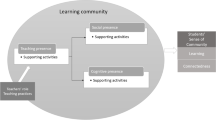Abstract
The purpose of this study was to measure sense of classroom community in a television-based higher education distance education course and in the same course taught by the same instructor in a traditional face-to-face learning environment, in order to determine if differences existed and if so to identify the nature of these differences. Participants for this study consisted of 120 adult learners who were enrolled in either of two sections of a semester-long undergraduate educational technology course offered by an urban state university. One section was taught tradiationally and the other section was taught to a small studio audience and at a distance to 24 remote classroom sites using synchronous one-way television and two-way audio technologies. Study results revealed a significantly lower sense of classroom community among learners in the distance education course, to include the studio audience.
Similar content being viewed by others
References
Bellah, R.N., Madsen, R., Sullivan, W.M., Swidler, A., & Tipton, S.M. (1985).Habits of the heart: Individualism and commitment in American life. New York: Harper & Row.
Brown, K.M. (1996). The role of internal and external factors in the discontinuation of off-campus students.Distance Education, 17(1), 44–71.
Bruffee, K.A. (1993).Collaborative learning: Higher education, interdependence, and the authority of knowledge. Baltimore: John Hopkins University Press.
Burge, E.J., & Howard, J.L. (1990). Audio-conferencing in graduate education: A case study.The American Journal of Distance Education, 14(1), 97–112.
Coldeway, D.O., Macrury, K., & Spencer, R. (1980).Distance education from the learner’s perspective: The results of individual learner tracking at Athabasca. (ERIC Document Reproduction Service, No. ED 259 228)
Collis, B. (1996).Tele-learning in a digital world: The future of distance learning. London: International Thomson Computer Press.
Dede, C. (1996). The evolution of distance education: Emerging technologies and distributed learning.American Journal of Distance Education, 10(2), 4–36.
Dillon, C. (1992). The study of distance education in the United States: Programs of study and coursework.The American Journal of Distance Eduction, 6(2), 64–69.
Egan, M.W., Sebastian, J., & Welch, M. (1991). Effective television teaching: Perceptions of those who count most_distance learners.Proceedings of the Rural Synposium, Nashville, TN. (ERIC Document Reproduction Service No. ED 342 579)
Fox, E., & Kieffer, L. (1995). Multimedia curricula, courses and knowledge modules,ACM Computing Surveys, 27(4) 549–551.
Frymier, A.B. (1993).The impact of teacher immediacy on students’ motivation over the course of a semester. Paper presented at the Annual Meeting of the Speech Communication Association, Miami Beach, FL. (ERIC Document Reproduction Service No. ED 367 020)
Goldstein, J. (1991). Research needs in distance learning: A practitioner’s perspective. In Moore, M.G. and Thompson, M.M. (1990).The effects of distance learning: A summary of the literature. (Research Monograph No. 2), University Park, PA: The Pennsylvania State University, American Center for the Study of Distance Education, (ERIC Document Reproduction Service, No. ED 330 321)
Hill, J.L. (1996). Psychological sense of community: Suggestions for future research.Journal of Community Psychology, 24(4), 431–438.
Hillman, D.C., Willis, D.J., & Gunawardena, C.N. (1994). Learner-interface interaction if distance education: An extension of contemporary models and strategies for practitioners.The American Journal of Distance Education, 8(2), 30–42.
Hiltz, S.R. (1998).Collaborative learning in asynchronous learning networks: Building learning communities. Invited address at the WEB98 Conference, Orlando, Florida.
Keegan, D. (1986).The foundations of distance education. London: Croom Helm.
McMillan, D.W., & Chavis, D.M. (1986). Sense of community: A definition and theory.Journal of Community Psychology, 14(1), 6–23.
Moore, M.G. (1992). Editorial: Three types of interaction.The American Journal of Distance Education, 4(2), 1–6.
Moorman, C., Zaltman, G., & Deshpande, R. (1993). Factors affecting trust in market research relationship.Journal of Marketing, 57, (January), 81–101.
Palloff, R.M., & Pratt, K. (1999).Building learning communities in cyberspace. San Francisco: Jossey-Bass Publishers.
Perraton, H. (1988). A theory for distance education. In D. Sewart, D. Keegan, & B. Holmberg (Eds.),Distance education: International perspectives, 34–45, New York: Routledge.
Prawat, R. and Floden, R.E. (1994). Philosophical perspectives on constructivist views of learning.Educational Psychology, 29(1), 37–48.
Preece, J. (2000).Online communities: Designing usability, supporting sociability. New York: Wiley & Sons.
Rahm, D., & Reed, B.J. (1998). Tangled webs in public administration: Organizational issues in distance learning.Public Administration and Management: An Interactive Journal,3(1).
Rheingold, H.R. (1991).Virtual reality. New York: Summit Books.
Rovai, A.P. (in press). Development of an Instrument to Measure Classroom Community.The Internet and Higher Education.
Russell, T.L. (1999).No significant difference phenomenon. Raleigh, NC: North Carolina State University.
Rutz, E., & Hajek, B. (1998).Collaborative distance learning using interactive video: Lessons learned from the University of Cincinnati/Ohio State University experience. Madison, WI: Distance Learning ’98. (ERIC Document Reproduction Service No. ED 422 870)
Sarason, S. (1974).The psychological sense of community: Prospects for a community psychology. San Francisco: Jossey-Bass.
Shaffer, C., & Anundsen, K. (1993).Creating community anywhere, New York: Perigee.
Sheets, M. (1992, Spring). Characteristics of adult education students and factors which determine course completion: A review.New Horizons in Adult Education, 6(1), 3–14.
Threlkeld, R. & Brzoska, K. (1994).Research in distance education. In B. Willis (Ed.),Distance education: Strategies and tools. Englewood Cliffs, NJ: Education Technology Publications, Inc.
Tinto, V. (1975). Dropout from higher education: A theoretical synthesis of recent research.Review of Educational Research, 45(1), 89–125.
Wiesenberg, F., & Hutton, S. (1995).Teaching a graduate program using computer mediated conferencing software. Paper presented at the Annual Meeting of the American Association for Adult and Continuing Education, Kansas City, MO, November 1995.
Wellman, B. (1999). The network community: An introduction to networks in the global village. In Wellman, B. (Ed.),Networks in the Global Village. Boulder, CO: Westview Press.
Zhang, S., & Fulford, C.P. (1994). Are interaction time and psychological interactivity the same thing in the distance learning television classroom?,Educational Technology, 34, 58–64.
Author information
Authors and Affiliations
Rights and permissions
About this article
Cite this article
Rovai, A.P., Lucking, R. Sense of community in a higher education television-based distance education program. ETR&D 51, 5–16 (2003). https://doi.org/10.1007/BF02504523
Issue Date:
DOI: https://doi.org/10.1007/BF02504523




